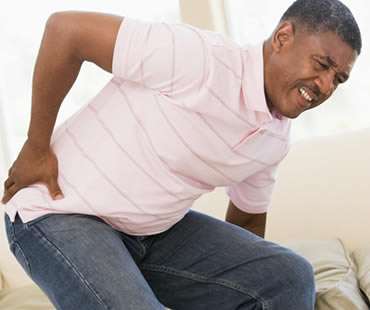The lower back, also called the lumbar spine, is a complex part of your anatomy that provides stability, flexibility, and strength for your whole body. It is comprised of bones, ligaments, muscles, nerves and joints that all work together. When your lower back is injured and the pieces don’t function normally, pain and significant incapacitation may result. Dr. Charla R. Fischer, MD at NYU Langone Medical Center in New York City treats people with lower back pain every day, as it is such a common complaint among patients.
What are the symptoms?
A wide variety of symptoms are possible with lower back trouble, ranging from mild to severe. It can progress gradually or begin suddenly. Some common symptoms with lower back pain include:
- Dull or aching pain in the low back
- Burning pain radiating from the low back to the rear thighs or into the lower legs
- Tingling or numbness, often called sciatica
- Muscle spasms
- Difficulty standing upright or walking
- Increased pain after prolonged sitting or standing
- Pain that decreases after changing positions
Lower back pain may be acute, which suddenly appears and lasts for a few days or weeks, then subsides as healing occurs. It might be subacute, lasting from 6 weeks to 3 months, or it could be chronic, which lasts more than 3 months and is often severe. Recognizing symptoms and getting a proper diagnosis from Dr. Charla R. Fischer, MD is the first step in effectively managing lower back pain.
What causes lower back pain?
As with many types of body damage, lower back pain may result from a variety of triggers. The most common cause of pain is a pulled or turn muscle or ligament. This can occur from heavy lifting, sports injury, poor posture, or sudden movement causes back pain. A strain of the lower back may occur gradually or suddenly, and can cause severe discomfort. Soft-tissue injuries or mechanical issues that create chronic low back pain may involve disc damage, nerve compression, or joint damage. Common causes of this type of damage are a herniated disc, joint dysfunction, degenerative disc disease, spinal stenosis, osteoarthritis, trauma, deformity, or compression fracture.
What about treatment?
Treatment for lower back pain should always be tailored to an individual’s needs. Depending on the condition and its severity, treatment may involve home care, medicinal remedies, alternative treatments, or surgery. Home remedies for lower back pain might include rest, activity modification, over-the-counter pain medication, or heat and ice therapy. Sometimes physical therapy is recommended to ease lower back pain, including options like stretching, strengthening exercises, low impact cardio exercise, or water therapy. Physical activity has proven to help maintain a healthy back, as pain or stiffness may increase when the spine goes unused. Medical treatment may be advised for some low back pain, when Dr. Charla R. Fischer, MD at NYU Langone Medical Center might prescribe muscle relaxants, stronger pain medications, steroid injections, or back braces. In severe lower back conditions in which pain does not improve after a few months of more conservative treatment, surgery may be the best way to ultimately improve your health. If you are experiencing lower back pain, contact Dr. Charla R. Fischer, MD today to get help in regaining your mobility and improving your comfort level.

